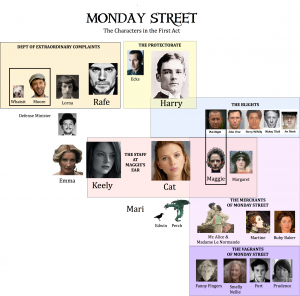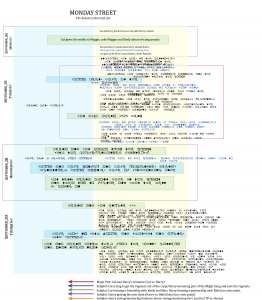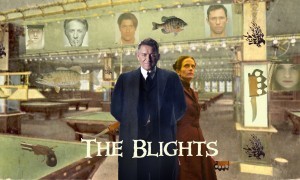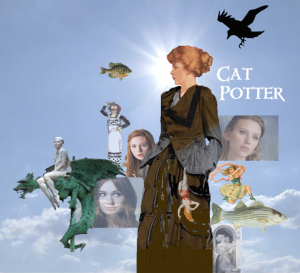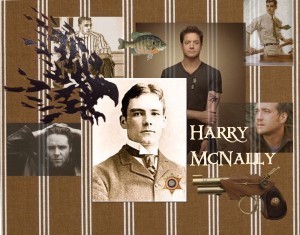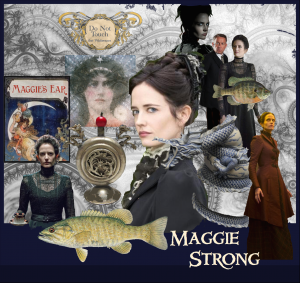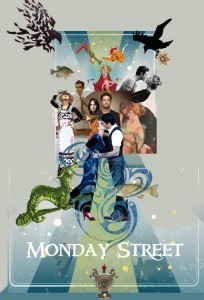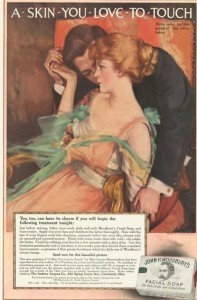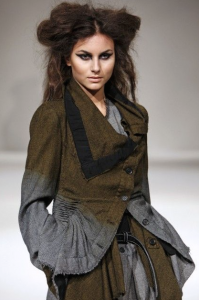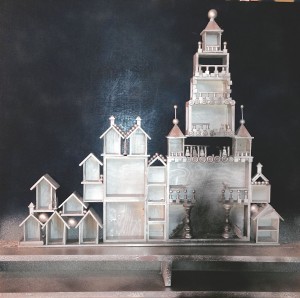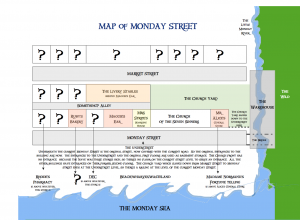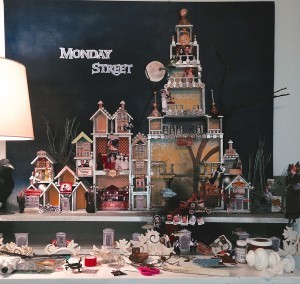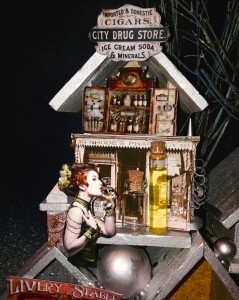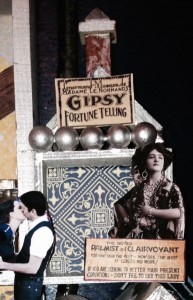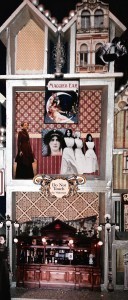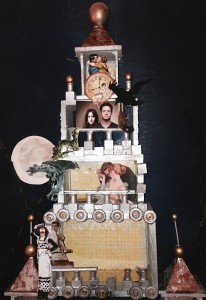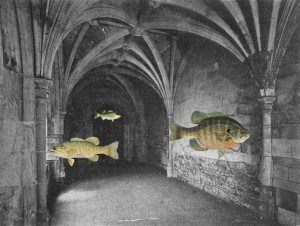Jennifer Crusie's Blog, page 261
October 29, 2014
The Monday Street First Act Character Map
I’ve talked before about character maps. They seem like a complete waste of time–my McDaniel students are never enthusiastic when I assigned them–but they’re the best way I know to see the relationships between and among the characters. Toni and I have added enough characters to the first act of the story that by now that we need a map. Here are the relationships in the first act:
Because there are so many characters to keep track of here (and we haven’t added Krissie’s yet), I did the charts for each act/story and then one for the resolution. It’s a way of seeing that our characters are moving in their relationships, that their situations are changing in the plot, that they won’t be in the same place at the end of the story. If I can chart it, I can see the story move from act to act.
For more about diagramming and charting and generally using pictures in the discovery and organization process, there’s this old questionable. One thing: I state very clearly not to do discovery until you’re done with your first draft, and obviously Toni and I are only starting our drafts. If you’re collaborating, you need to do this stuff early so you both understand each other’s characters and plots. You won’t really understand them until you’ve been through about three revisions of the book, but this kind of visual planning can really help communication among collaborators.
Edited to Add:
Last night Cherry Harpy asked about timelines.
At first, we blocked things out on a table in Word, but we’ve moved onto Curio now. Here’s a Curio chart divided into two columns, blue for Keely and yellow for Cat. I filled in Cat’s tentative stuff and then put it in Dropbox for Toni, but you can see basically what it looks like here:
The green and blue bars that span both columns are times when our characters share a scene, green for Keely and Cat and blue for Rafe and Harry. It’ll be a lot more complex in the third and fourth acts, but for the first two, this will work fine, especially since the stories in the first act take place at the same time. That is, they all start with the same event and then go down their separate paths. Those scene in the boxes will be in both stories that have those characters, they’ll just be told from different POVs, and since the characters are keeping big secrets from each other, the scene should shift dramatically with the PoV change. I have copy of this that’s marked with turning points for the main plot and subplots so I can make sure I’m not dropping anything, and I have notations for conflict and action so I don’t end up with any chat.
Normally, I’d be doing all of this with the second draft, but for a collab, we really need to know what’s going on up front.

The Birth of Whatsit
Sometimes people ask, “How do you think up these things?” I always say, “Thinking has nothing to do with it.” At least not in the logical-planning-train-of-thought kind of way. Another good thing about collaborating with somebody is when you’re done discovering a character, you have the e-mails to show you how you did it. So here’s how Whatsit came out of the nowhere and into the here, done entirely in e-mails (although this stuff was embedded in emails about other things, so this was background noise most of the day):
Jenny: There’s a weapon in video games called the BFG. For Big Fucking Gun. Might be something to bring out in the fourth act.
Maybe it’ll be a nightmare from the Dragon region, and the first time Moore identifies its egg or whatever, he says, “We have to take it back to the bookstore,” and somebody says, “Take what back?” and he gestures to it and say, “I don’t know what it is. The whatsit.” Leading to the end with Rafe saying, “It’s a good day for whatsits to die,” and Harry screaming, “You’re going DOWN, Whatsit!”
Or not.
Maybe Moore has a dog of indeterminate breed he calls Whatsit. We could pull that off. Something like this [picture sent].
Toni: You know, I keep “seeing” this ginormous Boogey-man kind of monster that, a long long long time ago, some DEC ancestor captured and squashed down into a dog-shaped vessel, and then stored (in stasis). Only she broke out of stasis somehow a long time before Moore came along, and when he came along, he just fell in love with her and worships her and since she thinks its her due, and she gets everything she wants and all this attention, she’s fine with that for now. She loves Moore right back. It’d be funny if, whenever someone has to pick her up, she’s really really heavy, for such a little dog. And then we can figure out what she really was later, when she has to come to Moore’s rescue. It’d be funny.
OR, I like the nerdy co-ed girl who dabbled too much in magic, but maybe a century or so ago, and she was corrupted to the point that she ended up this… thing… sort of a dog thing, and now she’s happy. Moore loves her (and God help him if he ever tries to date), and she loves him and sure, it’s dysfunctional and she has to pee in public, but the cookies are great and she can snuggle at night and really, she’s happy. Until someone is mean to Moore.
Jenny: I love this. I especially love the Moore romance, and when you pick this tiny dog up, she weighs 120. And she has feminine wiles and a great love of perfume. Possibly, there are bows?
Oh, what if she was a witch and did this to herself? I kind of hate making some victim a figure of fun, but if she screwed up a spell, she’s be a perfect mate for Moore,who’s brilliant but a little hazy on safety procedures. These two crazy kids just might make it.
Maybe she looked like this before the spell [picture sent].
Toni: It’d be really funny if she could still do a little magic. Or maybe she thinks she can, and it usually backfires. Opposable thumbs, so important.
And YES on the Whatsit before the spell.
You know Moore would plotz if he ever saw her.
Jenny: Yes on it backfiring. She has a lot of power, but she’s not good at thinking things through. I love the idea of them both being smart and talented and absolutely a danger to themselves and others.
So now we have Whatsit, and she’s useful because she’s going to cause the last thing that goes wrong in the crypt. (Moore is a CSI guy for the Department of Extraordinary Complaints. In his spare time, he runs a bookstore that’s not actually a bookstore, so don’t try to buy a book.)
Here’s Moore:
Here’s Whatsit:
And here’s Whatsit before her no good, very bad experiment:
I’m very relieved that Whatsit showed up because there weren’t any dogs in this book. Every book needs a dog.

October 27, 2014
The Crypt Problem
So we’re blocking out scenes, and I realize I have the wrong goal for Cat. I know it’s the wrong goal because she doesn’t give a damn about it. Scratch heat for the winter.
Now what she wants is to get workers out of her crypt. Basic background: Cat’s living in the belltower of an ancient condemned church and really likes it. But somebody has workers excavating the church crypt seven stories beneath her tower and she wants them out before they discover she’s there. Also it’s her church and they should leave.
And because I am obsessive about structure and three beats, I want her to actively try three ways to do it.
The first one she tries on her own. All I could come up with was stink bombs, which just, no. (She doesn’t want to hurt anyone, so that limits her choices.)
The second solution is to get Toni’s Keely to do something with magic. What we do not know.
The third solution she hits on by chance: she accidentally kills somebody (he deserves it) and tries to use the murder investigation to close up the crypt. That obviously has huge drawbacks, but she works with what she’s got.
What she doesn’t have are the first two attempts. So Argh People, get in here and brainstorm.
How would you get workers out of an ancient crypt to keep your home a secret? (The crypt is open to the sky now because a big explosion blew the ceiling out of not only the crypt but the entire nave. BIIIIIIG explosion.
I know you can do this. You got rid of a body for me for Agnes once, remember? I’ve never looked at Coca Cola the same way since.
So how would you do it?

Discovery Drafting
Every time I write a book, I have to learn how to do it all over again. I panic every damn time. One of the hardest things to remember is that I don’t really know what the book is about until I start writing. That is, my first (and second and third and fourth and . . ) draft is a discovery draft. I don’t know what I’m writing about until I see what I say.
This is really difficult for well-organized people (aka control freaks, aka me) to grasp. We know story structure, we know what the story’s about, we’ve done character discovery and mapped out the territory, we know all of that stuff. At the point where we sit down to write, shouldn’t it just be filling in the blanks?
The problem is, if you just fill in the blanks, the story’s dead. I think story is a living thing, buried in your subconscious, and when you raise it to the surface, it hits the air and changes, it absorbs everything around it, and becomes something new and alive. But if you don’t let it rise, if you put a brick on top of it and smother it with rules and plans, it’s always going to be something you constructed, not something you watched grow and blossom. You use rules and plans to rewrite, not to write.
That why the first draft has to be discovery draft, the draft that’s for only you to see, the draft where you can do anything you want. I started writing two nights ago, and my first knee jerk reaction was, “My god, this is lousy.” And then sanity reasserted itself: “Of course, it’s lousy, It’s first draft. First drafts are always lousy.” It’s a discovery draft. (My other term for this is the “don’t look down” draft, based in equal parts on something Ron Carlson said and on Wile E. Coyote, who runs off a cliff and is doing just fine. Then he looks down, realizes he’s on thin air, somebody hands him an anvil, and he’s done. Don’t Look Down, people.)
The second night, I went in and reread it, and it’s not good, but it’s not lousy, so I picked up and went on, and sure enough, I reached the end of a very bad scene, and thought, “That’s not going to work, that’s terrible.” But then analyzing why it was terrible showed me that I was undercutting my antagonist, making him a joke instead of a real threat. He wasn’t a character on the page yet, I hadn’t given him room to breathe, but I hadn’t realized that until I wrote him. Thank god for discovery drafts.
And then there was the supporting character I couldn’t quite figure out how to write. There was some complex layering there, foreshadowing I needed to get in, and I’d come up with any number of possible solutions, but when I started to write her, she was just there, the solution popped up on its own, and I thought, Of course. You can plan characters all you want, but you don’t really find them until you start the discovery draft.
That’s even true of character you think you know. I had done massive discovery work on my protagonist, but I still didn’t have her; I knew she was cheerful, pragmatic, and unflappable, but I didn’t know what that meant. Was she just going to smile through the whole damn book? Then at about 2AM that first night, I wrote this:
It was a beautiful clear night, so she was making good time past Phil’s shuttered pool hall when somebody grabbed her arm and threw her hard against the building.
“You owe me,” Joe Hinch snarled, taking a step toward her, and then he crumpled to the ground, revealing Harry McNally standing him behind him with a cosh.
“I’m going to say this one more time,” Cat said. “I can handle this myself.”
“You know, a lady would say thank you,” Harry said.
“Well, if that’s what you’re after, go save a lady.”
and there she was. “Unflappable” didn’t mean Pollyanna, it meant she stood her ground and didn’t flap. That’s a protagonist I can work with. (Yes, I know it’s lousy. I’ll fix it. It’s a discovery draft.)
Joe up there is the bad antagonist, bad in the sense that he’s just a snarling mugger. When I rewrote it, I gave him more of a chance:
It was a beautiful clear night, so she was making good time past Phil’s shuttered pool hall when somebody grabbed her arm and threw her hard against the building.
“You owe me,” Joe Hinch snarled, taking a step toward her.
Cat straightened and shook out her coat. “Are you trying to get yourself killed? What did Phil tell you about not touching the waitresses?”
Hinch said, “That’s in the restaurant,” and grabbed her arm.
“Okay, that’s fair,” Cat said and drew back her elbow to slam it into his throat when he crumpled to the ground, revealing Harry McNally standing him behind him with a cosh.
“I’m going to say this one more time,” Cat said. “I can handle this myself.”
“You know, a lady would say thank you,” Harry said.
“Well, if that’s what you’re after, go save a lady.”
Yeah, he still needs more work. Discovery draft, though. It’s working.
I was also having trouble with Phil Blight, the main antagonist for this story, a crime boss in the worst part of town. I wanted people to like him, but I wanted him to be a ruthless son of a bitch. The two traits didn’t seem compatible, and I was trying way too hard with him (he roared with laughter once and that’s when I knew I was grasping at cliches) and then this turned up as Phil warns Harry to stay away from Cat:
“I read the sign,” Harry said to Phil. “No touching the waitresses.”
“That’s for here in the Ear. What I’m telling you is, not outside of the Ear neither. Cat’s like a daughter to me. I been watching over her since she was twelve.”
“What happened when she was twelve?”
“I killed her father.”
Harry nodded. “And you drink the beer this woman brings you?”
“He was a bastard,” Phil said. “She was probably glad to see him go. Didn’t shed a tear at the funeral.”
“You went.”
“Course I went. It’s Monday Street. We pay our respects.”
“Right,” Harry said. “I will stay away from Cat.”
That’s too raw to stay as it is, but it won’t, it’s discovery draft. What it does give me is my way into Phil, so in that sense, it’s a huge success.
I mention all of this because I’m just re-discovering it (slow-learner here), but also because NaNoWriMo starts this Saturday. NaNo is basically a month of people all over the world writing discovery drafts together–that should cause a disturbance in the Force–and reporting their progress in word counts. (Lani Diane Rich’s first book was started in Nano, and it was also the first NaNo book published.) If you’ve been looking for a way to start a discovery draft, NaNo can be great because it doesn’t care how good your words are, just that you produce words, which means you’re practicing slinging those words onto the screen without second-guessing yourself about quality. It’s all quantity. You’ll have to rewrite, of course, but you can’t rewrite until you have words on the page to change, and NaNo gives you that.
The thing about discovery drafts is that they can be enormous fun once you put in a sock in your internal editor. Like all the other forms of discovery, they’re play, stuff that you’re doing not to create product–your discovery drafts are not going to be good enough to be published, accept that–but to find out about the story you’re creating. Once you can tell yourself, “discovery draft, don’t look down,” every time you start to panic, you’re on your way.
Oh, and here’s Phil’s composite. I like him, but he kills too many people:

October 26, 2014
Questionable: How Do You Make a Collaboration Work?
Kate wrote:
Here’s my question: How do you find other authors to write with. I’ve tried one joint project, but two out of four of us quit after our second session. They cited other commitments, but who really knows.
Obviously they need to be writers/people you trust. And I’m selfish, I want them to be better writers than I am so I can learn from them.
Do you have to find writers that write in the same style? The same tone? How exactly does this magic work?
So let’s do this in two sections:
“How do you find other authors to write with?”
Eileen proposed The Unfortunate Miss Fortunes to Krissie and me one night in a bar. I’d had a drink which means I was drunk because I cannot hold my liquor. She pitched the idea and I said yes. Mare is still one of my favorite heroines of all time.
Bob suggested we collaborate when we were both working at the Maui Writers Conference. As I recall, he handed me a glass of white wine, waited until I’d drunk it, and then said, “We should collaborate.” Agnes is still one of my favorite heroines of all time.
Alyssa Day proposed collaborating to Lani and me in a chat room. I was sober. We started working on Dogs and Goddesses (Lani’s title), and then her series took off and she had to write books for that, so she left the project (no worries, everybody was fine, it happens) and I told Lani I knew somebody and we invited Krissie in, and it was a blast. Shar is still one of my favorite heroines of all time.
I can’t remember who proposed Fairy Tale Lies, but the team was Lani, Krissie and I. We did some world building, but they had projects they had to do, and the project went dormant. Then we talked about doing novellas about mermaids in that world, and we did discovery work, but we were all swamped with different books and the project went dormant. We still talked about the world, we just didn’t do anything with it. But I loved the world, so I kept working and started the Zo stories, which I’m still working on, and then in September, Lani said, “I want to do a collaboration that works like a television series, episodes/stories that combine to make a season long arc, each one standing on its own as an episode, in that Fairy Tale world Jen’s been building.” And Krissie and I said, “Yes,” and I said, “Let’s ask Toni to play, too,” and they said, “Excellent idea,” and we asked Toni, and she said, “Yes,” and we got started, but Lani was working on a book and teaching, and Krissie was editing two books and dealing with taxes and upheaval at home, so they said they’d be back in a minute, and Toni and I started talking. A month later, Toni and are obsessively e-mailing and doing chat room stuff and building a much, much better world than I had started, Krissie’s still swamped but she’s starting next week, and Lani said last week, “I have to bow out,” so now it’s Toni, Krissie, and I, twelve stories/episodes to make a novel. I’m having a blast.
So looking back on this, I never start a collaboration, somebody always invites me. Having said that, I think the majority of collaborations don’t work because they are really, really, really difficult. You have to be incredibly flexible, with a big block of time you can give up to just talking about the story and the world, all the while knowing that when you get finished, you’re only going to get a third or a quarter of the money that comes in, and you have to compromise over and over and over again. So collaborations for the most part are not the way to go. In this case, it’s worth it for me because I love this world and I’ve got the Zo stories in it, and Toni’s had an idea for awhile that fits this world, so she’ll have that standalone novel, so what this collaboration is doing for the two of us is building a fantasy world–which is INCREDIBLY difficult–that we can then use for future stories we both already want to write. And Krissie, when she finally gets her slate clear enough to join us, will probably do the same. I can’t begin to tell you how much cleaner, clearer, sharper, more detailed, and more fun this world is after talking about it every day with Toni for a month. It’s been an amazing experience.
But I don’t think I’d ever go looking for collaborators. I like the ones I’ve worked with, I love the ones I’m working with now, but ask somebody new to collaborate? No.
“Do you have to find writers that write in the same style? The same tone? How exactly does this magic work?”
I’ve done five collaborative books, and some of those collaborations went smoothly and some of them did not. I’m proud of all the books, but I look back on some of those experiences and say, “Never again.” It’s just very, very difficult for writers, who are loners by trade anyway, to give up total control (this is me we’re talking about, too), and if you start out with different ideas of what the book is going to be about, it can be hell. If you have writers working with different tones, it can be hell. If you have writers who won’t compromise, it can be hell. But most of all, if you develop personality conflicts during the writing, you’re trapped and it’s mega hell. Having said that, I’m glad I did every one of those collaborations. I learned a lot, I made friends for life, and I wrote characters that I think are much richer because of the constraints of collaborating.
How do you find writers that work in the same style? Read their work. What I’ve found is that it’s more tone and approach than style. Krissie and Lani and I do not write in the same styles, but we have very similar senses of humor, and we approached Dogs and Goddesses seriously as writers, but we kept the tone light because our relationship was sunny. Our personalities and our life situations were perfect matches at the time we wrote. Bob and I had completely different styles, night and day, but we had the same approach to writing: completely professional, the story comes first, be able to justify what you want. So we’d hit places where we’d disagree, but we’d look at it from the point of view of the story: which choice serves this story we’re writing, something new for both of us, better. Bob was also very flexible: he gave in on a lot of things because he said up front he wanted to know more about writing for a female audience. He protected his character and his plot points to the death, and he was absolutely right to do so, but he was very open-minded the entire time. Toni and I have always had similar senses of humor, and I knew she and Lani and Krissie would mesh well, too, so I invited her in because I wanted to write with her and I thought she could bring a lot to the collaboration, and I was so right. So I think the key is finding people who think like you do and have personalities that are compatible with yours, at least as far as the approach to writing goes.
As for how the magic works, sometimes it does, sometimes it doesn’t. When Lani and Krissie and I finally got together to work on D&G in person, it took off, we couldn’t brainstorm fast enough, everything we did just exploded. No book is easy, but we had a damn good time on that one. Now, the three of us are out of sync in what we’re handling in our personal lives, they can’t give up everything and just sit down and write because things are pressing them, but Toni and I hit the collaboration at just the right time for us, and we’re working obsessively now, feeding each other’s creativity. Sometimes, it’s just timing. We’re both really looking forward to Krissie joining us in a week or two, and while she’s coming in after a lot of the world-building is done, what Krissie really loves is character, so we’ll show her the world and where the heroine she’s already established starts, and then we’ll listen to her as she brainstorms and move pieces of the world around to fit her story, and we’ll be fine. Of everybody I’ve collaborated with, Krissie is the easiest because she’s a peacemaker by nature, but also because she concentrates on her characters; so as long as she gets the love story her characters need, she’s completely open to everything else. If you find a collaborator like Krissie, grab onto her with both hands. She’s a gem.

October 25, 2014
Cherry Saturday: 10 25 2014
I almost forgot, it’s World Pasta Day.
Sophia Loren said she owed everything she had to spaghetti. Eat up, people.

October 24, 2014
Something New in Discovery: Quick Starts
Collaboration always has its difficulties, and one of them is getting everybody together at the same time, on the same page (so to speak). This time Toni and I are going full speed, but Krissie is in the middle of finishing a rewrite and moving her daughter home from college along with several other things, and she’s not going to be able to join us until November (aka next week). Toni and I are generating pages of e-mails and chat transcript, and it’s damn near impossible for us to keep it all straight, let alone Krissie coming in cold turkey on Nov. 1, so Toni and I decided a couple of days ago to do Quick Starts, named after those pamphlets that come with new electronics so you can get up and running quickly without RTFMing. So we’re writing Quick Start docs on the back stories for our characters, for the major locations, and for the major concepts, like magic. We’re writing them for Krissie, but what I’m finding out is that putting them together is making me thinking about the characters/settings/concepts in a much deeper way. I knew all of this stuff, I just hadn’t thought about it in the organized way it needed to be presented to Krissie. And the Quick Starts made me go back and look at the composites again and realize that they weren’t communicating character in a fully rounded way, either. I’m not sure I’ll do Quick Starts for non-collaborative books from now on, but I’m definitely doing them for the other stories I’m writing that are set in this world.
The key for me is getting the back story down and then forgetting it until I need it, which might be never because I hate back story. But it’s also getting the intangibles down, what the characters want, what they dream about, who they are at the start of the story. Knowing that, and knowing where they are at the end of the story, gives me their stories in their character arcs. Synthesizing a protagonist down to one short document and one composite image makes me thing really hard about what’s important (it’s not what they look like, usually), and above all, points out what I haven’t thought through at all.
Most of the Quick Starts are too spoilerish to put here, but I think Cat’s is pretty much a “previously in Cat’s life” with nothing of the book to come in it:
QUICK START: Cat Potter
Cat’s a sturdy, cheerful young woman, physically and mentally strong, focused, imperturbable, and completely uninterested in magic or love affairs or anything else but intensely practical matters and her heart’s desire: a safe, beautiful place to live up high in the sky. Cat was born to climb (her mother was a circus gymnast), and from the moment that her dad, one of Phil Blight’s men, caught her on the roof when she was three, he trained her to be a cat burglar. Now she’s the best cat burglar in the Edge (which means in Riven, too, since the Edge is Crime Central), and the second best pickpocket. (Best is Fanny Fingers, but she’s seventy-eight, so Cat’s turn is coming.) She and her father worked for Phil Blight until she was fourteen, when Phil killed her father for double-crossing him. By then Cat knew her dad wasn’t the brightest spoon in the drawer, but even she was surprised he was that dumb. She quit working for Phil then, but to his credit, Phil continued to take care of her and her mother, a circus trapeze artist who’d fallen for a bad boy and never managed to get up again, and who drank herself to death two years later. Phil offered Cat a permanent job high up in his gang—she was fearless about heights and could get in anywhere–but Maggie Strong stepped in and gave the sixteen-year-old a place to sleep in the waitress dormitory and a job sweeping floors at the Ear. Within a month, Maggie had recognized Cat for what she was—strong, smart, independent, and remarkably honest considering her upbringing (she never stole from family, friends, or employers)—and moved her up to waitress. Within the year she was Maggie’s second in command, and ten years later as the story opens, Cat has a rock-solid-secure honest job and only climbs on roofs if she needs something she can’t afford or when she just really wants to go high where the air is quiet and empty and she can stretch her arms out and breathe in the sky. It’s the only time she feels completely free. That’s how she found the bell tower on the ruined, condemned Church of the Seven Sinners. As spring warmed up, Cat began sleeping up there, making friends with a one-eyed raven by feeding it leftovers from Maggie’s Ear; the raven’s name is now Edwin, and he’s the closest thing to a pet Cat’s ever had. Her other pet, sort of, is a gargoyle/drainpipe named Perch. He’s made of stone, but Cat crawls out of the belltower and sits on him and feels like she’s flying on his back, and talks to him and pets him as if he’s alive. So she goes up to the tower and has blissful solitude and space and all the sky she can inhale, with Edwin and Perch to talk to, neither of whom talks back. It’s perfect.
But now it’s September and it’s getting damn chilly. Cat knows she’s doomed to go back to Maggie’s dorm, full of chattering waitresses, if she can’t find a way to heat the belltower while keeping it a secret that she’s up there because it’s illegal to enter the ruined, magic-contaminated church. Then things get more complicated. Cat looks down from the tower through the broken floor of the nave seven stories below and sees people moving around in the crypt. If they see her up there, her secret is blown. Of course, they’re not allowed in the church, either. She makes plans to steal a telescope so she can see what’s going on down there and goes to work, trying to figure out how to heat the tower as she goes. Her story starts that night at work .
Cat is 5’9”, strawberry blonde, round, commoner face (no cheekbones), strong as hell, imperturbable.
Cat’s theme is “God Help the Girl.”
Here’s her composite:
The other Quick Starts have too many spoilers, but here are three more composites, two for characters and one for a concept (romance plot):

October 23, 2014
Building a Protagonist Visually
Welcome to Discovery Month on Argh. It’s what I’m obsessing on right now, so you’re stuck with it.
If there’s one thing that’s a given about writing fiction, at least the way I write it, is that you find out most of what you need to know by writing the story. But when you’re collaborating on fantasy set in a world that you’re making up as you go, you do a lot of discovery with other people first. In this case, “other people” is mostly Toni, although Krissie will be back next week. So Toni and I do a lot of talking in e-mail, mostly floating ideas, comparing notes, and figuring out problems; the one thing we can’t do together is design our protagonists. But the one thing we have to do is introduce our protagonists to each other since they’re going to be in each other’s stories. So for the first time in a long time, I’m having to consciously do discovery on my protagonist before I write her, which makes it a lot easier to see how she develops. Of course, once I start to actually write her, all bets are off, but I really think I’ve probably got 50% of her, which is amazing at this stage. I won’t have 100% until the rewrites are finished, so 50% is a LOT.
At the very beginning, we did very basic descriptions, answering the question, “Who do you want to write about?” Krissie said, “A cross-dressing stable girl.” I think Toni said, “An assassin with heightened magical powers.” (Toni?) I said, “A cat burglar who works as a waitress and lives in a church belltower.” In all honesty, I have no idea why I wanted those things. I just did. But I know why I said the next part: “She has no magical powers and doesn’t want any.” That was in part to differentiate her from Keely, Toni’s character, but also, combined with the cat burglar and pickpocket stuff, it made Cat someone who was invested in stability, in concrete things like walls and roofs, somebody who felt the grooves in the stone as she climbed. I wanted Cat to be all physical skill and experience, no magic.
So I put together a composite of her church belltower (because where somebody lives is really important to me) and added a dragon gargoyle because I liked it and planned to make the gargoyle come alive later, although that may be gone now. Cat fed a one-eyed raven up in the belltower, but that was as close as she got to a pet. She worked at Maggie’s Ear as a waitress, and then she became Maggie’s dependable right-hand woman. So home, animals, work, friends, the basics. I wrote pages of description for her for our e-mail loop, then changed that and wrote pages more. I gave her a back story that will never see the light of day; I just needed to know it to write her in the now. And I made composite portraits of her over and over and over.
If you’re collaborating, you need to have pictures that you can show the other people and say, “This is what my girl looks like.” The problem with that is that the picture is probably of an actress in a specific role and it becomes too limiting. That’s why I like going through Google and pulling a dozen or so pictures that capture the spirit of the character, rather than just one that nails her to the board like a butterfly with a pin through her. If there’s not just one face, you don’t get fixated on that character/actress/personality. You have to look at all of the pictures to get the totality of the personality. Then you write the story and it all shifts again, but the composite still gives you a character with facets and layers. It gives you complexity.
But there’s another benefit to composites: They’re easy to change incrementally. As your knowledge of the character grows, you can pull out the pictures that don’t work any more and put in those that do, so that your portrait becomes sharper and more refined. Example: My first composite done a couple of weeks ago, and the one I’m working with now:

First Composite Portrait
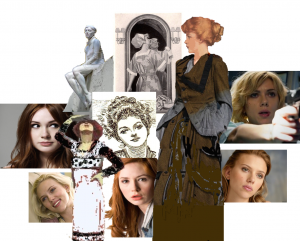
Cat’s Composite, 10-22-14
The second is the sixth version I’ve done, and you can see that there are only two pictures that stayed the same, the side-eye that to me summed up Cat’s noticing-but-not-saying-anything approach to others (although I stretched the photo to make her face wider and rounder), and the happy cleaning lady at the top that captured Cat’s working class cheerfulness. Cat’s pragmatic, hardworking, and she doesn’t do angst, but above all she’s cheerfully imperturbable. There’s one the picture in the first one I liked, the poster of the woman looking up. Cat loves heights, loves the sky, loves climbing to the top of things where she can get an unimpeded view. She does not wear fancy embellished dresses, though, so I did my usual Terrible Photoshop on the image and turned it into the dress and apron she wears to work at Maggie’s. The last pass, which will not be the last-last pass, more to come I’m sure, is about Cat being calm, strong, active, and centered. She knows who she is and what she wants. She’s stable. I think all of those images reflect that; there’s nothing there where she’s insecure or cute or even puzzled (although I think that picture in the lower left is going out next time). Surprised, yes, but not stunned. Cat handles things. And she likes to sit up high.
The other thing that was important to me in this particular composite was keeping the time period in mind. When I found a magazine ad from around 1910 that had a very calm, thoughtful strawberry blond, I said, “That’s Cat,” and pulled the image.
But she was dressed in a fancy party dress, and Cat wears practical things, so much Bad Photoshop with some couture from 2009 later, I had Cat swathed in 1910 street clothes (or a rough facsimile thereof), the kind a working girl might wear.
All of this fiddling around helps me find the physicality of the character. I don’t care what color her eyes are or her hair; I care about how she moves through the story. I care that she’s 5’9 and mostly muscle, not thin but lithe, strong, moves gracefully because she uses her body well, terrific balance, laid back to the point of leaning back a little when she watches people or talks to somebody, hands in her pockets, quiet, thoughtful, interesting. I need to see the physicality of that, not a bunch of driver’s license details. And that’s what the composite does for me.
Toni’s got one for her girl, too, and it’s helping me a lot. And then there are the composites for Harry, the love interest, and the romance plot composites . . . I need the sense of what I’m writing about, not the look, but a composite can help give me the look, too. Most of all, in a collaboration, those composites can keep everybody on the same page, writing about the same people.
Edited to add:
Motion character studies: How people move characterizes them, too:

October 21, 2014
Brainstorming Setting
Setting is more than location. It’s time, geography, weather, and people. It’s the wallpaper for your story, and just like wallpaper, poor choices and inadequate preparations can destroy the whole room story. We’re in the middle of brainstorming our setting–Toni and I at this point are obsessed–so I figured I’d give you an idea of how we’re doing it. Also, I don’t have time to write a blog post.
The working title for our book is Monday Street because that’s not just the location, that’s the state of mind. Monday Street is the bad part of the bad part of town, but it has its own laws (unwritten) and its own lawgivers (unelected), and it’s the wallpaper behind the actions of Cat, Mari, and Keely, our put-upon protagonists. That’s why I structured the collage around the street; the location in this book infused the entire story.
Monday Street is the former wealthy waterfront street of South Edge, across from the wharves of the Monday Sea. The main street of the Edge, aka the bad part of town, runs parallel to Monday Street, but once the streets hit South Edge, Monday Street is the power center. As we started brainstorming this, we knew that Cat lived in the belltower of the destroyed church and worked at Maggie’s Ear, Mari worked in the stables behind Maggie’s, and Keely lived in the Warehouse. That was pretty much it: four buildings. So when I started the collage which was for my stories–I don’t collage for the others because I can’t, their stories are theirs, I just leave room for their details in mine–I started with Maggie’s Ear and the church, and then built the rest of the street around them with the stuff I had on hand:
And then I though about what Monday Street meant to Cat, my character, and wrote this:
Monday Street is the main street of South Edge, so it’s a great place to get your pocket picked, wander down an alley and get mugged, or find a genuine fake relic that just fell off a truck. In the vernacular of New Riven, “He went down Monday Street” means roughly the same as “Here’s your Darwin award.” The architecture there is lovely because it was once the wealthiest part of town, beautiful townhouses across from a perfect beach, with a huge medieval church near the river. Then the Great War fought its last battle in South Edge and the magic fallout from the explosions made the entire borough uninhabitable. The two halves of the country agreed to part, using the Little Monday River as their border, and that split Riven City in half. The north half of the city became New Riven, a symbol of a bright new day, except for Forest’s Edge, now abandoned by the wealthy, soaked in magic, and the bolt hole for New Riven’s criminal population. So where Forest’s Edge was once the center of the city, now it’s the Edge, the last stop before the river and the desolation beyond that, the abandoned half of the city in Valden.
When the magic finally sunk to low enough levels that most of the Edge was clear, the city tried to reclaim it, but the criminal element had a firm grip on it and nobody with influence had any interest in rehabilitating the place (criminals don’t vote, and if they did, they’d vote against a rehab). In the interests of public health, the city focused on the last remaining magic toxin problem in New Riven, which was Monday Street. The lowest lying street in all of Riven, it still had magic at street level, so the city simply raised the road to the level of the second stories of the houses there, put in doors on the second level, and left the beach to rot. Smugglers put up makeshift wharves, and the white sand is long gone, but Monday Street thrives, and now enough time has passed that the original street level, now called the Understreet, is clear of toxins, too. The level below that, the basements and the crypt of the church, still have toxic pools, but nobody goes down there; the first floors of the buildings are the storage areas now, and everybody’s fine with that.
Monday Street, then, is where you’ll find the busiest criminal enterprises in the city, and the businesses that cater to them. Those include:
Rhodes Pharmacy, run by Martine Rhodes, a beautiful thirty-something known for her very fine eyes, her sexual appetites, and her ability to mix up damn near anything if you can pay her price. Favorite drink: absinthe with a dash of bitters.
Ruby’s Bakery, a bakery so good that people from the nice part of the city actually take their chances and send their servants there to buy bread. Ruby also operates a lunch counter inside the bakery, so that’s where Monday Street eats lunch. Ruby has strict rules like no magic inside the premises, but her Rumple is so good (a kind of stew inside one of Ruby’s amazing sour dough rounds) that people put up with the rules just to eat there. Plus if you break a rule, Ruby never lets you come back, and that’s unthinkable. Her granddaughter, Garnet works there, too.
The Department of Extraordinary Complaints: The only government office in South Riven, the DEC is where civil servants go to die. The head of the Dept is as yet unnamed, but his second-in-command is Moore, a doofus/genius who was demoted because of his many mistakes (but BRILLIANT insights) and who is now stuck running the Relics Room, the DEC’s evidence lock-up.
Maggie’s Ear: The hottest night spot in South Edge, probably because of the outdated gaslights, Maggie’s Ear is a bar and restaurant that opens at six PM and closes at six AM after serving breakfast. Jokes about Maggie being a vampire are made (she’s not), but not to Maggie’s face (she’s something else). She runs a very tight ship (Ruby copied her rules from Maggie’s) especially when it comes to her waitresses. Touch one of Maggie’s waitresses and you’ll never see the inside of the Ear again. She keeps a dormitory upstairs for any of the girls who want a free and safe place to sleep–not easy to find in South Edge–and an eye on everything that happens in her joint, especially if has to do with magic. Maggie has no time for magic. All of her waitresses are good, but three–Cat, Pansy, and Keely–are special. Moore from the DEC drops by to play piano most nights.
The Stables at the Ear: The stable’s behind Maggie’s Ear. Krissie will fill this in because that’s her Girl’s setting.
Mrs. Stripe’s Boarding House: Mrs. Stripe (not her real name, which is not unusual on Market Street) runs a boarding house, very respectable, two dollars a night for a room, paid in advance, please. All the rooms have striped wallpaper, hence her nickname. Harry’s living at Mrs. Stripe’s right now, and she thinks he’s a lovely boy. Quiet, though.
The Church of the Seven Sinners: Formerly the Church of the Seven Saints, this beautiful medieval house of worship had a hole blasted through the roof of its nave (not to mention the floor) when a magic orgy went wrong and exploded in its crypt. It’s theoretically condemned and deserted, but Cat’s living in the bell tower, and somebody’s digging in the crypt.
The Churchyard: Behind the Church and then running out to Monday Street farther down, the churchyard has beautiful grave markers and some small mausoleums. They’re still there because they’re too heavy to steal and impossible to hock. Nobody’s maintaining the churchyard now, so it’s overgrown, but it’s the closest thing Monday Street has to a park which means that at night, the grass moves. And sometimes moans. (That would be Monday Street lovers who have few inhibitions.)
The Monday Street General Store: Formerly the Church Parsonage, the General Store is run by Mr. Alice and has pretty much anything you want. (Mr. Alice bought the parsonage for a song when the magic finally settled down under the Understreet.) If it’s not in stock when you come in, Mr. Alice will have it for you by the next day, in most cases, practically new. Mr. Alice is cheerful and helpful and determined to make you buy something. Humor him.
Madame LeNormand’s Gipsy Fortune Telling: Madame LeNormand tells fortunes in Mr. Alice’s upstairs room (turn left at the housewares and keep going until you reach the weapons department. The stairs are behind the brass knuckles). There is speculation about how Madame pays her rent to Mr. Alice, but nobody would dream of actually asking.
The Warehouse: Once a convenient storage place for both sides of the city, the Warehouse sits high across the Little Monday River by the bridge into Valden. At least it used to. Over the years, the Warehouse has grown. It now covers the Bridge and is very slowly expanding down to the mouth of the bay. There is speculation about what will happen when it gets there. General consensus is that when it does, it’ll be a good time to be somewhere other than Monday Street. Oh, and it’s not abandoned: Keely lives there.
Here’s the working map, subject to a great deal of change:
You’ll notice there are question marks on the map. These are storefronts on the collage that haven’t been filled in, along with all of Market Street. We’re trying to brainstorm now what Monday Street residents might need–Mr. Alice sells groceries, too–that hasn’t been provided yet, on the theory that anything on Monday Street is there because the people of Monday Street want and need it. (Suggestions are welcome. The collage is here if you want another look.)
The map also helps keep us oriented. I was just talking with Toni about how Keely gets home from Maggie’s Ear when she gets off work. Toni said, “She goes down the Understreet to the Warehouse.” So I walked along with her in my mind, seeing what she’d see and realized that the church yard on the Monday Street side would slope down to Understreet Levels, so there must be a railing up on the current Monday Street. That means something to tip bodies over and something for Cat to climb, but also that there’s light in the Understreet there because it’s the one place that’ll be open to the sky. It’s the fictional equivalent of walking-the-terrain, and it opens up huge possibilities the same way the real walking-the-terrain does.
Between the map and the collage, I’m getting a grip on my setting which means I’ll be able to pretty much ignore it once I start writing in earnest. After all, it’s just story wallpaper.
But we think it’s great wallpaper.

October 20, 2014
The Monday Street Collage: Details Add Up
Mondays have turned out to be the day I look at the collage and see what I’ve done that week (fitting for a collage for a book called Monday Street), and what happened this week was relationships.
So first, the collage as it is now:
More detail, right? Sometimes it’s just more detail, period, sketching in some of the supporting characters and street detail, like Martine, the extremely shady pharmacist (her absinthe is criminally good) and Madame Normand, the fortune teller. (Yes, I know the absinthe is yellow. I couldn’t find my green food coloring so I used pickle juice. It’s not working.)
But I also found myself putting together important relationships in the story. For example, Toni’s hero drafts my hero into his organization, the black ops division for the country hidden behind the Department of Extraordinary Complaints, a low level bureaucracy where public servants go to die, so I needed to show that relationship, Harry up front as ever and Rafe in the background, working behind the scenes.
And then Toni’s girl, Keely, is undercover as a waitress in the same restaurant where my Cat works with another girl named Pansy who, we discovered this week as we brainstormed in e-mail, is a magic damper. So I did a lousy photoshop of their heads on waitresses from 1910 and glued them into the restaurant. The photoshop is lousy, but the possibilities of conversations among those women that the bad photoshop sparks are not. Plus putting them into the Ear gives them a context and restraints they won’t have in other settings. Plus those clothes. Talk about smothered lives.
And of course, there’s my romance. I had a good grasp on the relationship, but I wanted to really write the romance this time, so I googled for “vintage kiss” and then plastered my findings all over the collage to remind myself that this is a romance, damn it. Kiss the girl, Harry.
There are other details I added, like the air fish in the crypt and Perch on the bell tower and lots of details of Edwin, the raven, and some details I made bigger as Toni and I brainstormed the story and realized that things we thought were just details–St. Margaret, for example–were actually going to be major: if you’re major in the story, you get a bigger picture. And then some of it I just added because I liked it. There are a lot of windows in there. I liked the way the windows looked. It’ll probably turn out that those windows are important, but for right now, The Girls in the Basement said, “Ooooh, windows,” so we got lots of windows.
At the same time I’m doing the collage, Toni and I are maniacally brainstorming together on the world, putting up Pinterest boards, starting a brainstorming blog, keeping the story wiki up to date, so the collage is only one part of this discovery process. Sometimes I just do bad photoshops because I need to see what things look like. Like the air fish in the crypt:
But the collage is the touchstone for me. When it’s a little bit farther along, a couple more weeks probably, it won’t be finished, but I’ll look at it and it will put me into the story instantly. That makes all that bad photoshop worthwhile.


